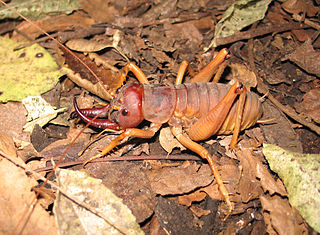
The Agromyzidae are a family of flies, commonly referred to as the leaf-miner flies for the feeding habits of their larvae, most of which are leaf miners on various plants. It includes roughly 2,500 species, they are small, some with wing length of 1 mm. The maximum size is 6.5 mm. Most species are in the range of 2 to 3 mm.

Gradungulidae, also known as large-clawed spiders, is a spider family endemic to Australia and New Zealand. They are medium to large-sized haplogyne spiders with three claws and two pairs of book-lungs similar to Mygalomorphae. Some species build extensive webs with an upper retreat tangle and connecting threads to scaffolding. This supports the ladder-like catching platform that is glued to the ground. Progradungula, a large spider with long legs like Hickmania, and Macrogradungula are the only cribellate genera of the family.
Springvalia isolata is a species of small freshwater snails which have an operculum, aquatic gastropod mollusks in the family Tateidae.

Agromyza is a genus of flies belonging to the family Agromyzidae. The adults of these flies can be recognised by the presence of stridulatory files on the first two abdominal tergites in both males and females. Another useful identifying feature is the halteres which are usually white or yellow, although they are darker in a few tropical species.
Herpystis isolata is a species of moth of the family Tortricidae. It is found in Nigeria.

The Mercury Islands tusked wētā,, also known as the Middle Island tusked wētā, is a large flightless insect in the family Anostostomatidae, discovered in 1970 living on a single small island in New Zealand. Distinguished by the enormous tusks with which males fight, it was saved from extinction by a captive breeding programme and translocation: the entire world population is descended from a male and two females captured and bred in captivity in 1998, just before the species went extinct in the wild. Motuweta isolata is the largest of the three tusked wētā species, and the most endangered wētā, ranked Nationally Critical by the Department of Conservation.
Agromyza parvicornis, the corn blotch leafminer, is a species of leaf miner flies in the family Agromyzidae.
Agromyza pseudoreptans is a species of leaf miner flies in the family Agromyzidae. It has been known to feed on Urtica dioica and Urtica pilulifera both of which are nettles.
Agromyza pudica is a species of leaf miner flies in the family Agromyzidae.
Agromyza ambrosivora is a species of leaf miner fly in the family Agromyzidae.
Agromyza sulfuriceps is a species of leaf miner fly in the family Agromyzidae. It mines leaves from Potentilla plants.
Panorpa isolata is a species of common scorpionfly in the family Panorpidae. It is found in North America.
Agromyza aristata, the elm agromyzid leafminer, is a species of leaf miner fly in the family Agromyzidae. It is widespread throughout eastern North America, creating leaf mines in Ulmus americana.
Agromyza reptans is a species of leaf miner fly in the family Agromyzidae.

Agromyza albitarsis is a species of leaf miner fly in the family Agromyzidae.
Agromyza diversa is a species of leaf miner flies in the family Agromyzidae.
Agromyza frontella, the alfalfa blotch leafminer, is a species of leaf miner flies in the family Agromyzidae. Larval instars of this species engage in cannibalism.

Agromyza vockerothi is a species of leaf miner fly in the family Agromyzidae, found in North America. The larva of this species feed on brambles (Rubus).





